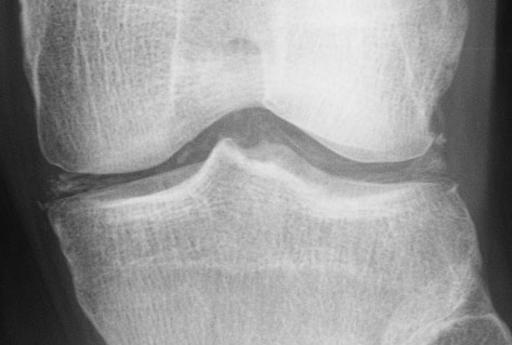Residents' Pages
A 73-year-old white man presented with constant pain in his elbow. His pain had been gradually worsening over the previous 6 months and was not relieved by analgesics. Additional symptoms included diffuse arthralgias, swelling of both feet, and fatigue.
The patient's past medical history was significant for cardiovascular, pulmonary, renal, gastrointestinal, and musculoskeletal ailments. He had been a "heavy" smoker and "heavy" drinker.
Physical exam was remarkable only for swelling and tenderness of the left lateral epicondyle. A radiograph of the distal left humerus lateral epicondyle showed a well-- defined punched-out extra-articular lesion with accompanying ill-defined cortical erosion (Figure, A). Bone scan demonstrated significant uptake in the lesion.
A simultaneous computed tomography-guided fine-- needle aspiration and core biopsy of the elbow lesion was performed. The aspirated and core biopsy specimens were white-gray and granular.
The cytology smears on light microscopic examination showed numerous foreign body giant cells, histiocytes, occasional neutrophils, and amorphous debris mixed with blood on Diff-Quik (Figure, B), and Papanicolaou (Figure, C) stains. Polarization of the air-dried Diff-Quik-stained slides revealed abundant intracellular and extracellular needle-shaped crystals that were birefringent and bright yellow (Figure, D).
Subsequent light microscopic examination of formalinfixed, paraffin-embedded core biopsy stained with hematoxylin-eosin revealed well-circumscribed, pale gray-- white amorphous material surrounded by an inflammatory histiocytic reaction and occasional foreign-body giant cells (Figure, E). Polarization of the biopsy revealed no crystals.
What is your diagnosis?
Pathologic Diagnosis: Gouty Tophus
Gout results from effects of hyperuricemia. This crystal-- induced arthropathy is characterized by deposition of monosodium urate crystals in joints and tissues from supersaturated extracellular fluids. The deposition of crystals in joints and periarticular soft tissue leads to arthritis and bone destruction.1
The clinical manifestations of gout include formation of tophi, arthritis, and nephropathy. Approximately 90% of the first attacks of acute gout are mono-articular and usually affect the first metatarsal joint of the foot. Gout can affect any synovial joint, although the joints of the lower extremity are predominantly affected.1
Gout is predominantly a disease of adult men, with a peak incidence in the fifth decade of life. However, it is the most common cause of inflammatory arthritis in men in their 30s.1 Women develop gout at an older age. The onset of gout before the age of 30 in men or before menopause in women is atypical, and these patients should be investigated for an associated inherited enzyme defect or renal disease.2 The prevalence of gout has increased over the last few decades in the United States and other countries with a high standard of living.
The clinical diagnosis of gouty tophus is easily established if the clinical and radiologic features are classic.3 On radiographs, the bony defects are almost always the result of deposits of tophi in the bone. The bone destruction cannot be reversed, although tophi in soft tissue may resolve with therapy. The late stages of gout may show dystrophic calcifications in the affected areas.1 Gouty tophi and pseudogout (chondrocalcinosis articularis) are in the differential diagnosis of periarticular nodules. Pseudogout results from deposition of calcium pyrophosphate dihydrate crystals, which are rhomboid-shaped, blunt-ended crystals with weak birefringence upon polarization.4
Demonstration of monosodium urate crystals is the gold standard for the diagnosis of gout.3 Fine-needle aspiration is a quick and less painful alternative to synovial biopsy and fluid analysis for the demonstration of crystals.5,6 As demonstrated in this case, monosodium urate crystals are often lost after formalin fixation and histologic processing. The crystals are preserved in air-dried cytologic smears, making polarization of crystals possible.5,6 In Papanicolaou stains, the crystals may be dissolved in the hydrating steps. If histopathology of a tophus or synovial biopsy suggests gout, fine-needle aspiration may be an alternative for crystal identification and subsequent definitive diagnosis.
References
1. Bullough PG. joint diseases. In: Sternberg SS, Antonioli DA, Mills SE, Carter D, Oberman HA, eds. Diagnostic Surgical Pathology. 3rd ed. Philadelphia, Pa: Lippincott Williams & Wilkins; 1999:230-232.
2. Buckey TJ. Radiologic features of gout. Am Fam Physician. 1996;54:12321238.
3. Schumacher HR Jr, Reginato AJ. Atlas of Synovial Fluid Analysis and Crystal Identification. Philadelphia, Pa: Lee & Febiger; 1991.
4. Chivukula M, Shidham G, Shidham V. Pathology quiz case: crystal deposition disease of the knee joint. Arch Pathol Lab Med. 2001;125:705-706.
5. Rege J, Shet T, Naik L. Fine needle aspiration of tophi for crystal identification in problematic cases of gout. Acta Cytol. 2000;44:433-436.
6. Nicol KK, Ward WG, Pike EJ, et al. Fine needle aspiration biopsy of gouty tophi: lessons in cost-effective patient management. Diagn Cytopathol. 1997;17: 30-35.
Bill Zaloga, DO; Jamie L. Hughes, MD; Rana S. Hoda, MD
Accepted for publication July 23, 2001.
From the Department of Pathology and Laboratory Medicine, Medical University of South Carolina, Charleston, SC.
Reprints not available from the author.
Copyright College of American Pathologists May 2002
Provided by ProQuest Information and Learning Company. All rights Reserved



